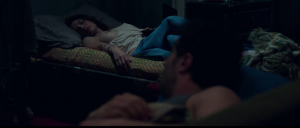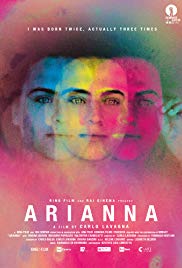In film, the most powerful device in constructing the interpretation of a character by the audience is the gaze that is crafted by the director. When women in film are constructed this is most often by a male director, leaving the product to showcase a woman who is presented as a sexualized spectacle. The films Yesterday, Today, and Tomorrow (1964) by director Vittorio De Sica as well as Gabriele Mainetti’s They Called Him Jeeg Robot (2015) are a continuation of the problems facing female depiction in film. Through the objectifying male and pedophilic gazes of each respective film, the woman’s purpose in relation to the audience is left to be determined by the male behind the camera. However, it is the film Arianna (2015) which embodies a queer gaze, that offers a very different interpretation of the female identifying experience on camera, though still crafted in part by male director, Carlo Lavagna.
The cinematic gaze in film is what constructs a narrative by using the camera angles to depict a type of interpretation for the audience. The result is the effect on the audience and how the characters are interpreted based on this construction. This is not up to interpretation by the spectator as “the gaze is…prepared” (Morawski 40). The impact that a gaze can have on characters can vary, as it can both leave an empowering position as well as a vulnerable or exploited stance as well. Because the gaze is manifested in the production process, it is critical that the person crafting the gaze be reflective of the power dynamics at play in their decision making (Morawski 40).
The film Yesterday, Today, and Tomorrow is a prime example of what the male gaze intends to accomplish. As Laura Mulvey writes, “film reflects, reveals, and even plays on the straight, socially established interpretation of sexual difference which controls images, erotic ways of looking and spectacle” (6). Of the many sensual scenes in the film by De Sica, there is none more telling of this objectification by the male gaze than the famous striptease by actress Sofia Loren in the story of a Roman prostitute named Mara. She is the definition of a woman’s portrayal as reduced to a mere spectacle of lust and desire of the male audience. As Mulvey goes on to assess, there is a sense of a “primordial wish for [the] pleasurable looking” that Loren is able to aptly satisfy as she literally performs for not only the male in her frame, but also the male audience to which she is also exhibiting her sexuality (8). And while this confidence that Loren could be considered empowering, this showcases that the relevancy of this empowerment is rendered moot by the fact that Loren is not doing this for herself; it is to allow the “curiosity…to look [and] intermingle with a fascination” (Mulvey 8).
The male gaze, as Mulvey analyzes is centered upon the “active/male and passive/female” dichotomy (9). Interestingly enough, this is actually quite the opposite in this film as Loren is actively seducing and Mastroianni is passively receiving her sensuality. He remains in the same position the entire time he is watching her, while Loren is the one moving in different spaces throughout the room. Their presence on the screen is in fact “coded for a strong visual and erotic impact” (Mulvey 9). This is evident especially in this film, because despite the two preceding story lines, this is the story that encapsulated the entirety of the work and specifically the striptease itself. Promotional works often centered Loren’s final character front and center. In this photo the seductive nature of the male gaze on Loren is so pronounced not just in its placement, but also because it is the only story colorized on the poster.

Promotional Poster for Yesterday, Today and Tomorrow (1964)
The camera angles throughout the striptease end up reflecting the two perspectives to which the male gaze is embodying. First the male on the screen and second, the male audiences that the film is attracting and pandering to with this elicit scene. The third angle captures Mastroianni’s reaction, but these shots from Loren’s perspective are minimal at best, indicating that her viewpoint is not the focal point of this narrative. The duality of the angles also reflects this theory of the two male perspectives due to the fact that the spectator is identifying with the male on the scene who is receiving the seduction, in this case, by Loren. As Mulvey point out, this male is effectively a proxy or a “screen surrogate” to the male audience member (10). Loren therefore cannot make an appearance as anything other than an “isolated, glamorous, on display [and] sexualized” muse (11).
When considering another take on a more recent film regarding female interpretation through a gaze, They Called Him Jeeg Robot is not much better at showcasing a changing perspective on the female body. The issue here is that although Aleesia is an adult woman, she is presented as a child with her mental and behavioral state. As Danielle Hipkins addresses that despite the character’s mentality as a girl, it was far more problematic that the directors decided to “cast a 30-year-old woman to play this girl-woman-child.” It makes the whole situation seem confusing as her behavior does not reflect the sexuality that is being exuded simultaneously. In the scene surrounding Alessia’s first night in the care of Enzo, her sleeping body is immediately sexualized with nudity. It is further punctuated by the camera’s angles to depict the viewing of her body from a higher angle. This ends up framing the audience effectively as an adult viewer looking down on a child. The fact that her character is played by an older woman than her mental state would suggest is criticized by Hipkins as it is clearly intentional in the choice of this problematic dichotomy of a girl-woman for the director (269).

Aleesia Sleeping in They Called Him Jeeg Robot (2015)
Throughout later scenes, the audience sees Alessia’s childlike demeanor continue to be sexualized by her body, which includes the different gestures she would make. At one point she is eating a yogurt from the pack without a spoon, focusing the attention on her fingers in her mouth, again sexualizing the mundane. In this scene, she is continuously depicted as a child sexualized, as she is found watching the TV on the floor in the morning which is reminiscent of a child’s behavior. However, because she is scantily dressed combined with her glances up at Enzo that are a cross between childishly lost and “archly seductive”, leave her in a space that is ultimately exploited at the time of her rape (Hipkins 269).
The nudity and the general construction of seduction through innocence is a problematic way to view the characterization of a woman in any sense. The fact that this is further stipulated as a result of a man behind the camera, is even more so considering that even in the fifty years following Yesterday, Today, and Tomorrow’s overt objectification of Loren through the cinematic lens, once again this occurring in a distinct and revolting fashion on a character that is being sexualized along, if not for her childlike behavior.
However, with Arianna we see that there is a chance for a different kind of interpretation of the female body with the queer gaze regarding the intersex condition of the main character. The queer gaze is distinct from the previous conceptualizations of the female body, especially as it is able to create a dialog about queer identity without the traditional sexualization of the unknown or unfamiliar (Anderson). Although there is just as much nudity and even sexual scenes that present themselves, they are never done in a way that is voyeuristic or indicative of an objectifying stance.
Director Carlo Lavagna dictates this way of creating the conceptualization of the titular character’s body by ensuring that he was taking on the perspective of a woman not only himself, but also looking for guidance from other members of his production team (Lavagna). The gaze here in the scene where Arianna is exploring her body, is not done in a lucrative fashion, but rather in a way that allows the discovery to be presented as simply that, regardless of its sexual origins. The eroticism that could certainly be developed by a more careless director is evident, as the angles do not sexualize Arianna, but allow her the space to understand herself.

Arianna in the Pools, Arianna (2015)
The implications surrounding this paradigm shift for a gaze that was previously contingent on the exploitation of the female image is what is the most astounding. Although They Called Him Jeeg Robot and Arianna were both released in the same year it is interesting to see that despite this, the films were both dependent on the approach of the director and their ability to be cognizant of their interpretation of the woman before their lens. That being said, although this is a wonderful change, the reality is the visual conceptualization of women is still dependent on a man’s ability to see them as more or as just a sexual object.
Works Cited
Anderson, Tre’vell. “What Hollywood Can Gain by Placing the ‘Queer Gaze’ in the Spotlight.”
“Arianna: the Woman Who Was Borne Three Times.” Cineuropa.
De Sica, Vittorio, director. Yesterday, Today and Tomorrow. Compagnia Cinematografica Champion, 1963.
“De Sica and His Dynamic Duo Do What They Do Best: Close-Up on
‘Yesterday, Today and Tomorrow.’” Mubi.com.
Hipkins, Danielle. “Performing ‘Girl’ Against Girlpower: The Case of Lo Chiamavano Jeeg Robot (Mainetti, 2015).” The Italianist, vol. 37, no. 2, 2017, pp. 268–272.
Lavagna, Carlo, director. Arianna. Ring Film, 2015.
Mainetti, Gabriele, director. They Call Him Jeeg Robot. Goon Films, 2015.
Morawski, Jakub. “The Cinematic Gaze of the Other: How Are Images Watching You?” The International Journal of the Image, vol. 7, no. 4, 2016, pp. 35–41., doi:10.18848/2154-8560/cgp/v07i04/35-41.
Mulvey, Laura. “Visual Pleasure and Narrative Cinema.” Feminisms, 1975, pp. 438–448.
Rojo, Amara V, and Nicoletta Marini-Maio. “An Interview with Carlo Lavagna .” 8 Apr. 2019.
Screenshot from They Called Him Jeeg Robot on Netflix. 13 May 2019.
